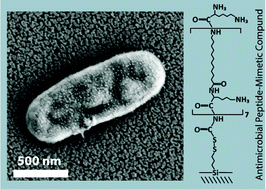Optical biosensors for bacteria detection by a peptidomimetic antimicrobial compound†
Abstract
In this work we present a label-free optical biosensor for rapid bacteria detection using a novel peptide-mimetic compound, as the recognition element. The biosensor design is based on an oxidized porous silicon (PSiO2) nanostructure used as the optical transducer, functionalized with the sequence K-[C12K]7 (referred to as K-7α12), which is a synthetic antimicrobial peptide. This compound is a member of a family of oligomers of acylated lysines (OAKs), mimicking the hydrophobicity and charge of natural antimicrobial peptides. The OAK is tethered to the PSiO2 film and the changes in the reflectivity spectrum are monitored upon exposure to Escherichia coli (E. coli) bacterial suspensions and their lysates. We show that capture of bacterial cell fragments induces predictable changes in the reflectivity spectrum, proportional to E. coli concentrations, thereby enabling rapid, sensitive and reproducible detection of E. coli at concentrations as low as 103 cells per mL. While for intact bacterial cells, the K-7α12-tethered PSiO2 shows a poor capturing ability, resulting in an insignificant optical response. The biosensor performance is also studied upon exposure to model Gram positive and negative bacterial lysates, suggesting preferential capture of E. coli cell fragments in the presented scheme. These OAK-based biosensors offer significant advantages in comparison with conventional antibody-based assays, in terms of their simple and cost-effective production, while providing numerous possible sequence combinations for designing new detection schemes.


 Please wait while we load your content...
Please wait while we load your content...